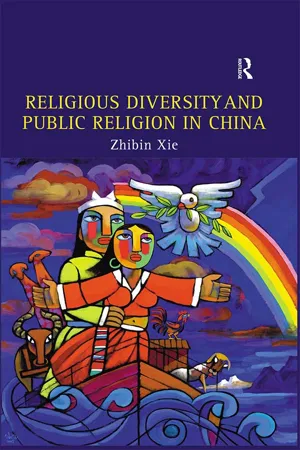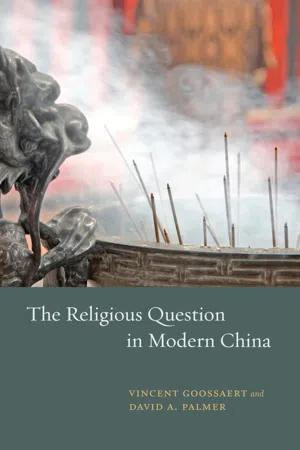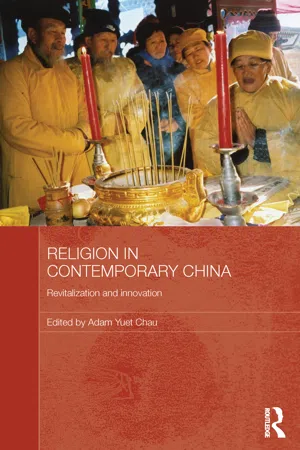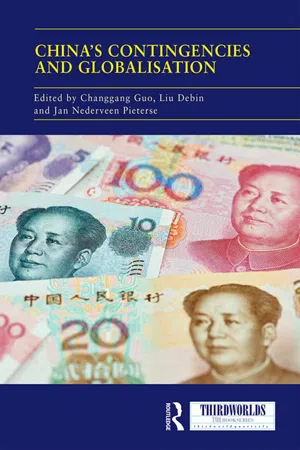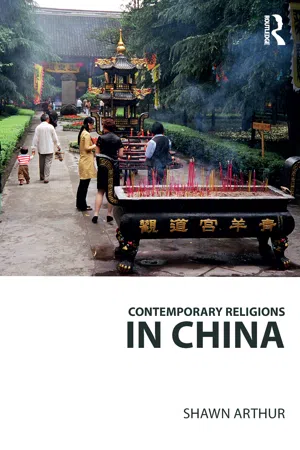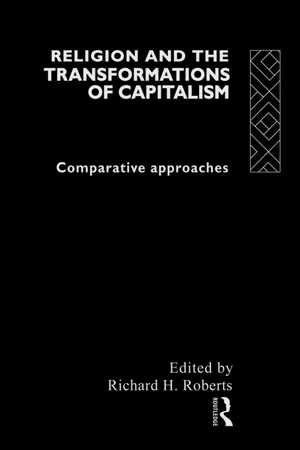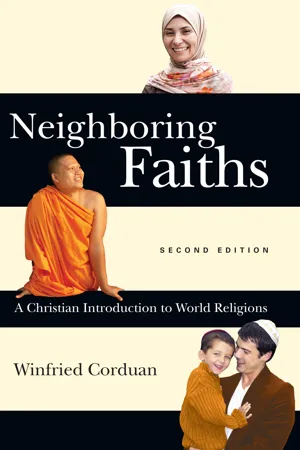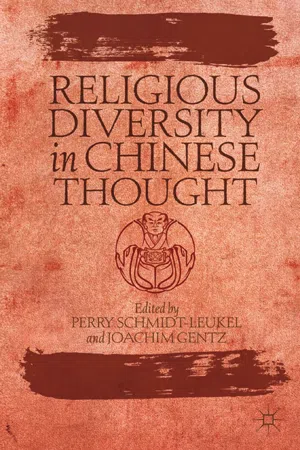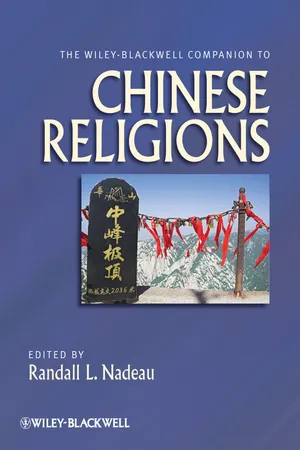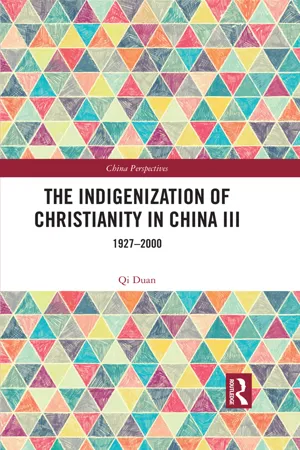History
Modern China Religion
Modern China's religious landscape is diverse, encompassing Buddhism, Taoism, Islam, Christianity, and folk religions. The Chinese government officially recognizes five religions, but there are also numerous unregistered religious groups. Religion in modern China is influenced by historical traditions, government policies, and globalization, leading to a complex and evolving religious environment.
Written by Perlego with AI-assistance
Related key terms
10 Key excerpts on "Modern China Religion"
- eBook - ePub
- Zhibin Xie(Author)
- 2017(Publication Date)
- Routledge(Publisher)
PART II Religion and its Political Context in ChinaPassage contains an image
Chapter 5 Religion in ChinaIn the Chinese context, it is important to note that religious engagement in public political culture relies not only on the construction of democratic institutions but also on the special characteristics of religion in China.1 In this part I will describe some major features of religion in China and its political context, with particular attention to the relationship between religion and the state, especially in communist China. These features will impact on how the relation between religion and politics will unfold in China.5.1Religiosity and Religious Diversity in ChinaBefore discussing the political role of religion in China, it is necessary to define the religious character of Chinese society.2 It has been pointed out that “as much as 80 percent of China’s population may be termed ‘religious’ if customary beliefs and practices in the countryside are included.”3 In my view, China is a religious country essentially by virtue of its rich and widespread traditions of religious practice (when and where allowed), beliefs, and religious life, especially in rural areas and among ethnic minorities throughout the country.4 These religious beliefs and practices play an active role in Chinese society, even though the current state is secular due to the dominant atheistic political ideology. I agree with C.K. Yang’s view of the continuity of religious influence in the life of common people, who are expected not to challenge communist ideology in contemporary China: “Theistic beliefs remain a strong influence among the people in spite of persistent interference and systematic control from the new faith. The current picture is one of both a new nontheistic faith and the old theistic traditions.”5C.K. Yang then cites at least two factors that show the importance of religion in Chinese society. One is “the high density of temples and shrines” in the whole society. The other is that many religious beliefs are largely diffused into social life, thereby becoming an integrative force for social institutions and organized groups; as Yang puts it, “the dominance of the diffused structural form made religious influence pervasive.”6 - eBook - ePub
- Vincent Goossaert, David A. Palmer(Authors)
- 2011(Publication Date)
- University of Chicago Press(Publisher)
It is possible, therefore, to speak of a “modern” urban religious culture in the Chinese world, with structural characteristics that are shared by the different movements described, albeit with different degrees of emphasis in different groups and traditions, and in the specific contexts of different political regimes. In speaking of an urban Chinese “religious modernity,” however, we should be careful not to assume a radical rupture with traditional types of religiosity. For instance, a defining characteristic of modern religiosity as defined by sociologists is the voluntary and personal nature of participation, where individuals worship out of their free choice, as opposed to kinship groups or ascriptive communities as collective units. In China, however, although traditional cults have usually been managed by corporate, kinship, or territorial communities, individual and voluntary worship, at temples or in groups freely chosen by the worshipper, has always been a fundamental form of religious practice. From the perspective of the individual worshipper, then, the transition from ritual participation in a communal territorial temple to a private entrepreneurial temple does not represent a radical rupture. Furthermore, lay Buddhist and salvationist groups have provided pathways for long-term personal spiritual commitments for centuries.At a basic level, then, the emergence of religious modernity can be said to be characterized by a shift in the relative importance of preexisting forms of Chinese religiosity, from the ascriptive communal cults employing religious specialists to voluntary, congregational, and body-cultivational styles. The extent of this shift was to a great degree influenced by political and economic conditions. At one end of the spectrum, in Taiwan, one found the greatest degree of coexistence and circulation between the two types of religiosity (with local temples offering qigong courses, for instance), while at the other extreme, in the cities of Mainland China and North America, the near total absence of communal cults left the space wide open for modern forms of religiosity. Entities like Hong Kong and Singapore were situated somewhere in between.Another point of continuity—which is also the defining “modern” characteristic of most of these movements—is their conscious identification with tradition, in relation to, though not necessarily in opposition to, a modern secularist culture in which religion is constantly obliged to justify itself, often resorting to modernist or scientific arguments. The traditions thus formulated can be considered “reinvented” in the sense that they create new compositions out of selected elements of tradition—elements often selected for their perceived compatibility with modern, secular values. At the same time, the “traditions” thus created defined themselves in relation to the West, constituting Chinese nationality and ethnicity within a cosmopolitan context. In all cases, the goal was to find an authentic Chinese essence or morality at the same time compatible with, or constituting an alternative form of, universalism. While the tension between the Chinese nature and universalism, and attempts to reconcile the two, was manifested in each movement, the emphasis on either side of the equation varied. In qigong , the redemptive societies, and the Confucian movements, the stress was clearly on Chinese tradition defining itself in relation to the West and asserting a new, Chinese-centered universalism that other nations could potentially adhere to. The conscious and explicit syncretism of some of these movements partook of a project of creating a unified Chinese tradition vis-à-vis the West.76 The reformist Buddhist groups combined a doctrine and practice both solidly rooted in Chinese history and thought, and part of a sophisticated global community. At the other end of the spectrum, Christianity, which offered the strongest symbolic connection to universal Western modernity, should not be seen as a rupture with Chinese tradition: the strong moral emphasis of the evangelical Protestantism most popular among Chinese was often explicitly perceived by believers as incarnating the essence of Chinese values of virtuous conduct, filial piety, and hard work.77 - eBook - ePub
Religion in Contemporary China
Revitalization and Innovation
- Adam Yuet Chau(Author)
- 2010(Publication Date)
- Routledge(Publisher)
1 IntroductionRevitalizing and innovating religious traditions in contemporary ChinaAdam Yuet Chau
Before the modernist transformations of the twentieth century, China had one of the richest and most diverse religious cultures in the world. The radical anti-traditionalist policies of both the Republican and Communist regimes as well as other socio-historical factors posed formidable challenges to China’s religious traditions but also presented new opportunities for regeneration and innovation. The economic reforms and the concurrent relaxation of religious policies have provided fertile ground for the revitalization of a wide array of religious practices including divination, ancestor worship, temple festivals, spirit mediumism, going to the church or mosque, funeral rites, exorcism, pilgrimages, sectarianism, sponsoring sutra chanting, printing and distributing morality books, etc. At the same time, apparently new forms of religious practices have emerged such as lay Buddhist preachers, “Maoist shamans” (Chao 1999), and a bewildering number of qigong sects/schools. How do we explain this remarkable religious effervescence? Which of these religious practices are revived old practices and which are invented new practices? How are religious innovations made possible? What are the different processes and mechanisms of religious revivals and innovations? What factors (historical, political, social, economic, etc.) impact upon these processes and mechanisms? What kinds of innovation emerge that are clothed in traditional idioms or appear to be radical breaks from tradition? And more broadly, what does the Chinese case of religious revitalization and innovation tell us about the nature of religious tradition and the larger issue of cultural continuity and change?This collection of essays will address these crucial questions by focusing on the processes and mechanisms of religious revitalization and innovation in contemporary China. The contributors are an international, interdisciplinary team of experts who have all conducted in-depth fieldwork research in China on different aspects of religious revitalization and innovation. The contributors work in the fields of anthropology, ethnomusicology, history, religious studies, and sociology, and are affiliated with institutions in the US, Europe (the UK and France), and China (including Hong Kong). Each of the eight substantive chapters is based on a case study of a specific religious phenomenon (or a cluster of related religious phenomena) and provides analytical keys to understanding issues of revitalization and innovation. - eBook - ePub
- Changgang Guo, Liu Debin, Jan Nederveen Pieterse(Authors)
- 2018(Publication Date)
- Routledge(Publisher)
2 Since the management of religion has been deeply rooted in Chinese culture, it is little wonder that today’s government also prefers this means of ruling.The state’s suspicion of and interference in religion is not only a short-term policy driven by Marxist ideology and measured in terms of decades. It is also a long-established practice measured in centuries or even millennia, one rehearsed countless times by emperors and their bureaucrats long before the actions of today’s cadres.3China was governed by an autocratic monarchy from the time that the First Emperor of the Qin Dynasty unified the whole country in 221 BCE. Later, in 134 BCE Confucianism was taken as the orthodox ideology in the Western Han Dynasty through the ‘Ban the hundred schools of thought except Confucianism’ movement. Even before Buddhism entered China during the reign of Emperor Mingdi in the Eastern Han Dynasty (around the first century of the common era), this political culture of an autocratic monarchy united with orthodox Confucianism remained in place, never to be shaken in the following two millennia. With such a strong regime, China failed to form religious organisations comparable to the Christian church in mediaeval Europe. Religion in China thus did not have the power to challenge the secular monarchy. Furthermore, with various religions coexisting, each with its own sphere of influence and interests, it was difficult to form a joint force. The prominent Chinese scholar, Zhuo Xinping, believes that this church–state model is different from the US–Western concept of the ‘separation of church and state’ and belongs to a particular ‘state-lead, church-follow’ mode with Chinese characteristics.4 - eBook - ePub
- Shawn Arthur(Author)
- 2019(Publication Date)
- Routledge(Publisher)
2 Setting the stage and defining terms‘Religion’ in China
When I began to study contemporary religions in China in 2004, I encountered a rather unexpected circumstance as I spoke with people in various religious sites. As we spoke, we had some difficulties communicating what we meant. Many people did not want to talk about so-called ‘religious’ things or practices, and most people disavowed being ‘religious’ or following a particular ‘religion.’ So I had to find appropriate ways to speak with people about their practices and ideas – and their overall meanings. As 2004 was my first trip to China, I did not know anyone who could help me with this dilemma. Eventually I began to make some Chinese friends and had a Chinese roommate, and they were able to discuss their perspectives with me. They helped me to untangle the nuances of the language and ideological differences that I had encountered.Having clarified in the previous chapter some necessary concepts that have influenced my research and writing – and which will help you to understand the larger foundations upon which this project rests – we can proceed to the critical analysis of some key terms related to ‘religion’ that we will use throughout this text (such as ‘religion’ and ‘laity’). Our discussion of these important terms focuses on how they are understood within Chinese contexts – which provide very different meanings than are common in the West. As scholars Yao and Zhao argue:Religious ideas and ideals are expressed through language, and different languages carry with them different cultural and philosophical values. To fully understand Chinese religion, we must carefully examine its key concepts in Chinese language, most of which cannot be simply rendered into one particular English word or phrase. Thus, although we use English terms or phrases to explain such concepts as religion, religious experience, religiosity, religious culture, spirituality, worship, cult, belief, myth, magic, Heaven and so on, we must bear in mind that their English connotations are not the same as those of the Chinese words themselves. - eBook - ePub
Religion and The Transformation of Capitalism
Comparative Approaches
- Richard H. Roberts(Author)
- 2012(Publication Date)
- Routledge(Publisher)
As was already mentioned, the period after 1977 (after the ‘Gang of Four’ had been arrested), when Deng Xiaoping assumed supreme control of the government, was a time of great changes: drastic economic and social reforms, but timid political changes were accompanied by a revival of religion. This was indeed a ‘turning of the tide’ in many respects and the people’s mood started to become more cheerful, since greater economic prosperity was the result of the government’s switch toward modernization. While keeping the economic-political changes in the background, our focus here will be on the changes in the area of religion. Three questions will be answered: first, are the Chinese people today religious?; second, how do the government and the scholarly world look at the ‘problem of religion?’; and third, what is happening to religion among the people, usually called the ‘masses’ in government documents?First of all, are the Chinese people today religious? Various answers have been given. One scholar states: ‘The people of China are indifferent to religion because Confucian ideology, with its emphasis on ethics, has long been dominant’ (Luo Zhufeng 1987, trans. 1991:30). On the positive side, ‘At present, quite a large number of people in China believe in religion’ (Maclnnis 1989:40). Another voice states,‘…it is interesting that communist Chinese scholarship has assisted us in identifying the presence of religious beliefs and sentiments, as well as the survival of religious communities in mainland China’ (Ching 1990:125). Julia Ching concludes, ‘that the Hindu civilization is much more religious in character than the Chinese. On the other hand, when one sees the temples and churches, and witnesses the fervour of individuals and communities in worship, one cannot but admit that religion is also alive in China’ (Ching 1990:126).10Of course, the educational impact of forty years of Marxist indoctrination should not be minimized; neither should the CCP’s explicit demand that party members cannot be religious believers. Moreover, while the constitution grants freedom of religious belief, it does not extend this freedom to the practice of superstition. Several articles published in 1964 clarify what superstition means; listed as such are ‘fortune-telling, physiognomy, casting of horoscopes, geomancy, and even the worship of local Chinese deities like the earth god and the dragon king’ (Bush 1970:26). Other popular traditions such as temple-oracles, the burning of spirit-money, and the recourse to mediums for advice and the cure of diseases were equally stamped as superstitious. However, strict standards to discriminate religious belief from superstition are hard to formulate, which leaves a great amount of opportunistic discretion in the hands of the government executives. - No longer available |Learn more
Neighboring Faiths
A Christian Introduction to World Religions
- Winfried Corduan(Author)
- 2013(Publication Date)
- IVP Academic(Publisher)
There appear to be three major centers of Chinese religion outside of the People’s Republic today: Taiwan, Singapore (and radiating out from there into Malaysia), and Hong Kong (including Macao and a few other locations). Of the three, in Taiwan there appears to be a relatively greater separation between Buddhism and Daoism, probably because over the last twenty years Buddhist organizations have acquired a great amount of wealth and are able to establish purely Buddhist centers all over the country, and Daoism has followed its lead. What this amounts to, of course, is not so much a different version of Chinese popular religion as a slow dissolution of it. Perhaps in the distant future Daoism will need to be treated entirely separately because its synthesis with Buddhism will have completely come apart, but that scenario does not seem likely. Regardless, that time is not yet here and may never come, and we can’t forget about the other two ingredients: traditional religion and Confucianism.At present, then, in Chinese folk religion these constituents come together, along with other elements, to make up the complex system that is the faith of millions. Chinese popular religion continues to develop. By its very nature it is fluid, adaptable and subject to various influences. For example, the currently popular emphasis on female deities, particularly Mazu (Ma-tzu, also known as Tianhau [T’ien-hau], the queen of heaven) and Guanyin (Kuan-yin, the female manifestation of the male Buddhist bodhisattva Avalokitesvara), has come to blossom over the last two hundred years. We can expect the synthesis to continue to evolve into new forms in the future under the impetus of modern communication. In this chapter we will look at each of the various systems of origin and how they have come to shape Chinese popular religion today.Traditional Religion
Mythological Origins . Chinese culture treats old age as a noble attainment, and when it values a particular item or practice, it seeks to endow even relatively late developments with a venerable heritage. Thus it is not easy to separate what is said to be ancient from what actually represents earliest antiquity. For example, it is virtually conventional wisdom among traditional Chinese people that prior to the Shang dynasty (c. 1766 to 1027 B.C. ), there was the Xia dynasty (c. 1994 to 1766 B.C. ).[3] - eBook - ePub
- P. Schmidt-Leukel, J. Gentz, P. Schmidt-Leukel, J. Gentz(Authors)
- 2013(Publication Date)
- Palgrave Macmillan(Publisher)
Chinese scholars have begun to address the relationship among religions. Duan Dezhi, for example, mentions religious dialogue and pluralism in his An Introduction to Religion. 10 Wang Xiaochao pays even more attention to religious dialogue and world peace. 11 Zhang Zhigang has written comprehensively about religious dialogue. 12 And Wang Zhicheng has devoted himself to translating and writing books about religious relationships. 13 In sum, religious studies in Chinese have experienced short but fast growth from the early single theory of Marxist religious theory to traditional resources of Chinese religions and interest in modern religious theories that pay more attention to interreligious relationships. D EVELOPMENT OF C HINESE M ODERN C HRISTIAN T HEOLOGY There are many religions in China, and each religion has its own theology. I do not want to discuss the theology of every religion here. Instead, I focus on the construction of Chinese Christian theology. Christianity diffused into China early in the Tang dynasty and in the later Yuan dynasty, but it did not develop its own theological systems. When Matteo Ricci went to China in the late sixteenth century, he felt that he could not carry out his missionary work without recognizing the indigenous culture and faith. He finally cooperated with Confucianists to actively adapt Chinese culture to Christian theology. In the late Ming and early Qing dynasties (seventeenth century), Western missionaries cooperated with Chinese scholar-bureaucrats in translating and writing a great number of theological works. However, they did not construct an independent system of Chinese Christian theology. The Chinese Rites Controversy (late seventeenth to early eighteenth centuries) was a serious setback for the development of a Chinese form of Christianity (in this case Catholicism). It is still hard for Chinese Christians in modern China to develop an independent system of theology - Randall L. Nadeau, Randall L. Nadeau(Authors)
- 2012(Publication Date)
- Wiley-Blackwell(Publisher)
Local strata of religion were neither sanctioned by the imperial government nor organized from within any central governing organ. Indeed, partly as a result of this lack of official recognition by the imperial state, and the lack of institutional definition as legitimate bodies of religious practitioners, scholars have often imagined the many regional varieties of Chinese religion to be an unorganized hodge-podge of superstitions that lacked coherence. Intellectuals have sometimes understood local religion to be a rural or low-class phenomenon, and therefore have indiscriminately and somewhat disparagingly referred to it as “popular religion.” While it is true that the religion of the people was not organized in ways similar to the major three traditions in terms of self-conscious denomination, or in terms of institutional charisma, the assumed lack of coherence is a fallacy. Despite obvious regional variations there were equally obvious similarities. Moreover, while local religion was certainly “popular,” the term “popular’ ”should only be understood in the sense of a large number of followers, and not in any sense that might exclude the participation of the various cultural, political, economic, or even religious elites. (For further discussion of the designation “popular religion,” see Chapter 10, CHINESE POPULAR RELIGION.)In terms of sheer numbers, indeed, Chinese religion during the Ming and Qing massively revolved around local temples in the neighborhoods of communal settlements. These communities might be found in (or even defined as) rural villages and regional market towns, but also in capital cities such as Nanjing or Beijing. There was no categorical distinction between rural and urban temples, or the religion practiced in them. Temples primarily lodged divinities that had once been known as living beings associated with a particular region. First and foremost they were local heroes who had protected their communities from danger, often involving spectacular feats of martial prowess. From the large number of legends that present their heroes as skilled demon-slayers, it appears that most local temples fulfilled the function of territorial protection, and that the powers of these local gods were invoked in order to exorcize the intrusion of demons that caused such calamities as drought and disease. Local communities identified themselves closely with these heroic tutelary saints, taking pride in the construction and maintenance of impressive temples devoted to their local hero.- eBook - ePub
- Qi Duan(Author)
- 2022(Publication Date)
- Routledge(Publisher)
29 This indicated that the Church should pay increasing attention to the relationship between Christ and (the Chinese) culture. Meanwhile, the theology developed by the Chinese Church gradually proceeded from being concrete and pragmatic to being metaphysical and ontological.In this period, unlike the older generation theologians who focused on the comparative study of Christianity and ancient Chinese classics, the Church had shifted focus to the real, living Chinese culture, which is the popular Chinese culture that exerts a subtle influence on the Chinese and penetrates into their everyday life. A new generation of leading Chinese Christians held that the living culture greatly outweighed the dead classics. At this point, Chen Zemin said:[A blend of Confucianism, Buddhism and Daoism (including folk religion)] has seeped into traditional Chinese culture. this phenomenon occurred among the intellectual elite as well as among the common people. The Chinese may be agnostic or indifferent towards organized religion, but there are very few staunch, rational atheists in China and even they have been unable to shake off the influence of Chinese culture. thus, in discussing the indigenization of Christianity in China, if we confine ourselves to placing Christianity and Confucianism/Daoism/Buddhism side by side and pointing out the parallels or similarities between them, we risk neglecting the masses, who are also the inheritors and transmitters of Chinese culture. this is a mistake which many scholars and theologians seem to have made, or indeed are still making.30This living traditional Chinese culture was religiously embodied in the non-exclusiveness of Chinese religion. The vast majority of Chinese people are tolerant of religions. It is generally held among the Chinese that religions teach people to do good. Overall, the Chinese attitude towards religion is syncretic. The Chinese develop a holistic view of the universe and realistic unities of opposites, such as heaven and earth, heaven and man, yin (passive/shaded force) and yang
Index pages curate the most relevant extracts from our library of academic textbooks. They’ve been created using an in-house natural language model (NLM), each adding context and meaning to key research topics.
